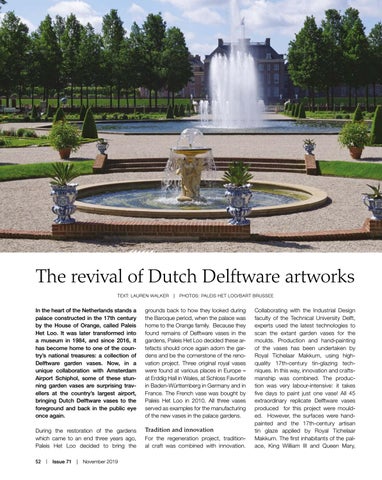The revival of Dutch Delftware artworks TEXT: LAUREN WALKER | PHOTOS: PALEIS HET LOO/BART BRUSSEE
In the heart of the Netherlands stands a palace constructed in the 17th century by the House of Orange, called Paleis Het Loo. It was later transformed into a museum in 1984, and since 2016, it has become home to one of the country’s national treasures: a collection of Delftware garden vases. Now, in a unique collaboration with Amsterdam Airport Schiphol, some of these stunning garden vases are surprising travellers at the country’s largest airport, bringing Dutch Delftware vases to the foreground and back in the public eye once again.
grounds back to how they looked during the Baroque period, when the palace was home to the Orange family. Because they found remains of Delftware vases in the gardens, Paleis Het Loo decided these artefacts should once again adorn the gardens and be the cornerstone of the renovation project. Three original royal vases were found at various places in Europe – at Erddig Hall in Wales, at Schloss Favorite in Baden-Württemberg in Germany and in France. The French vase was bought by Paleis Het Loo in 2010. All three vases served as examples for the manufacturing of the new vases in the palace gardens.
During the restoration of the gardens which came to an end three years ago, Paleis Het Loo decided to bring the
Tradition and innovation
52 | Issue 71 | November 2019
For the regeneration project, traditional craft was combined with innovation.
Collaborating with the Industrial Design faculty of the Technical University Delft, experts used the latest technologies to scan the extant garden vases for the moulds. Production and hand-painting of the vases has been undertaken by Royal Tichelaar Makkum, using highquality 17th-century tin-glazing techniques. In this way, innovation and craftsmanship was combined. The production was very labour-intensive: it takes five days to paint just one vase! All 45 extraordinary replicate Delftware vases produced for this project were moulded. However, the surfaces were handpainted and the 17th-century artisan tin glaze applied by Royal Tichelaar Makkum. The first inhabitants of the palace, King William III and Queen Mary,
